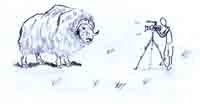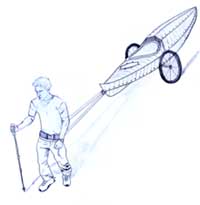 |
Overview of Expedition
In July & August 2005, Chris Bray (Explorers Club member and Australian Geographic Society’s ‘Young Adventurer of the Year’ 2004) and Clark Carter will head deep inside the Arctic-Circle. The goal of our 2-man team is to hike unsupported across Victoria Island – the ninth largest island in the world. If successful, this will be a world-first. North of the Canadian mainland, Victoria Island is in the ‘High-Arctic’ with its eastern half embedded in the frozen Arctic Ocean. The passage between this island and Canada forms part of the historically famous ‘Northwest Passage’ – the much sought after trading route from the Atlantic Ocean to the Pacific.
 Being unsupported means we have to bring everything we need with us from the start – a weighty burden of over 150kgs each. To transport this, we will each have our own P.A.C. - our acronym for Paddleable Amphibious Cart. A P.A.C is essentially a special-purpose kayak with detachable wheels that Chris has designed and we've both built from sheet aluminium. After discussing our needs with some kayak manufacturers, no ordinary (even Kevlar re-enforced) kayak would survive what we will have to put them through. It is a hybrid sled, canoe, cart, white-water kayak and storage container all in one.
Being unsupported means we have to bring everything we need with us from the start – a weighty burden of over 150kgs each. To transport this, we will each have our own P.A.C. - our acronym for Paddleable Amphibious Cart. A P.A.C is essentially a special-purpose kayak with detachable wheels that Chris has designed and we've both built from sheet aluminium. After discussing our needs with some kayak manufacturers, no ordinary (even Kevlar re-enforced) kayak would survive what we will have to put them through. It is a hybrid sled, canoe, cart, white-water kayak and storage container all in one.
The majority of our route is through unexplored regions due to its extreme isolation. Scientists, Archaeologists, and the local people are excited by the potential for discoveries and valuable cultural, biological and geological findings. "No one goes to the places you are headed, and as far as I know, no one’s been." We are undertaking research and data collection en-route for organisations including ‘Environment Canada’ and ‘Canadian Wildlife Service’.
 Victoria Island is an island of extremes, both in landforms and climate. Summer is short and spirited, confined largely to July with temperatures normally above zero degrees Celsius. In winter the thermometer plunges to 40 below zero in the perpetual dark, thus, we have a brief window of opportunity in which to take on this challenge.
Victoria Island is an island of extremes, both in landforms and climate. Summer is short and spirited, confined largely to July with temperatures normally above zero degrees Celsius. In winter the thermometer plunges to 40 below zero in the perpetual dark, thus, we have a brief window of opportunity in which to take on this challenge.
Because we will be travelling approximately 500km north of the Arctic Circle in mid summer, there will be over 1,000 hours of perpetual daylight before we see the Sun first set. Our 1,000 km route will take us from the islands most easterly point to the most westerly, through different landscapes, terrain and wildlife – each presenting their own unique challenge. Of the estimated 65-days this journey should take, the first few weeks should see us hauling along the side of the frozen ocean, accompanied by seals, beluga whales and polar bears that inhabit this pack-ice. Polar bears present a serious hazard, but we have covered this danger and associated preventative measures in this document.
After a few hundred km of frozen coast, we strike inland. The island is mostly flat, low lying and open. There are no trees, only rolling hills of wind-swept tundra or grass, swamps, expanses of shale and bare rock, glacial moraines and a network of rivers interconnecting a myriad of lakes – thousands upon thousands of lakes, none of them particularly large yet together we’d say 1/3 of the surface of the island is water. Herein lies one of our biggest challenges – with such diverse terrain to negotiate, no one standard means of transport will suffice – hence the need for our special P.A.C..
 When crossing solid ground, we will haul our individual P.A.C.s behind us on large, broad wheels hinged at the balance point. With about 70kgs stowed in each end, a normal kayak wouldn’t last long before it bent and buckled in the middle. When we venture over soft ground where the wheels sink in (swampland or shale), we simply swing the wheels backwards onto the deck, and bodily drag the P.A.C like a sled – so it needs a reinforced, fairly flat bottom.
When crossing solid ground, we will haul our individual P.A.C.s behind us on large, broad wheels hinged at the balance point. With about 70kgs stowed in each end, a normal kayak wouldn’t last long before it bent and buckled in the middle. When we venture over soft ground where the wheels sink in (swampland or shale), we simply swing the wheels backwards onto the deck, and bodily drag the P.A.C like a sled – so it needs a reinforced, fairly flat bottom.
Every time we come to a lake or river that has thawed out (about 30% will remain frozen in July), we simply launch our P.A.C, and paddle across, so it needs to have similar characteristics to a canoe. We will paddle our P.A.C.s down approx 300km of the ‘Kuujjua River’ (‘Big River’ in Inuit). This river – which only thaws out a few weeks before we arrive – varies from wide slow meandering sections, to class 3 white-water. Hence our P.A.Cs also have to handle some fairly serious rapids for several weeks. Some rivers we need to cross flow at the bottom of steep valleys – carved out by the action of glaciers years ago. We will need to lower our gear down into these valleys and haul them slowly up the other side. After this, we hike along the southern coastline fronting a liquid ocean, and haul onwards to the far end of the island.
Wildlife
Victoria Island has one of the world’s most concentrated populations of musk ox, sharing the island with wolf packs that shadow herds of caribou waiting for their chance. Arctic fox, polar bears, seals and even some endangered species inhabit the island. Swans, snow geese and other waterbirds abound, as do mosquitoes and flies in plague proportions for a brief 2-week period in early August.
World First
 Many adventurers claim things to be world firsts, but our research and enquiries indicate that no one has ever set out to cross Victoria Island before, let alone unsupported. At the suggestion of Eric Philips (First Australian to both the north and south poles, along with companion Jon Muir), we asked ‘The Explorers Club’ (and their Canadian branch), ‘Canadian Geographic’, ‘The Alpine Club of Canada’ as well as others, and all were very interested in our adventure and had certainly never heard of anyone crossing the island. Further, they said they had never heard of any expedition like this at all - one so diverse and novel. As Eric Philips said “Victoria Island is an admirable destination. I see too many people following the same old routes...yours is distinctly different. Great stuff!” After having talked at length with many long-term residents of the island, Inuits and highly respected arctic travellers, we have decided to claim it as a world-first as nobody has ever heard of such a crossing, or anything even remotely similar!
Many adventurers claim things to be world firsts, but our research and enquiries indicate that no one has ever set out to cross Victoria Island before, let alone unsupported. At the suggestion of Eric Philips (First Australian to both the north and south poles, along with companion Jon Muir), we asked ‘The Explorers Club’ (and their Canadian branch), ‘Canadian Geographic’, ‘The Alpine Club of Canada’ as well as others, and all were very interested in our adventure and had certainly never heard of anyone crossing the island. Further, they said they had never heard of any expedition like this at all - one so diverse and novel. As Eric Philips said “Victoria Island is an admirable destination. I see too many people following the same old routes...yours is distinctly different. Great stuff!” After having talked at length with many long-term residents of the island, Inuits and highly respected arctic travellers, we have decided to claim it as a world-first as nobody has ever heard of such a crossing, or anything even remotely similar!
This expedition really is quite a novel undertaking. It’s in no way a standard arctic kayaking or white-water expedition, nor a traditional A -> B overland hike or Arctic traverse, a mountain climb, a place whose attraction is mostly scenic beauty or historic importance, simply a feat of endurance or world-first – it is ALL of these things combined together in one diverse and exciting challenge – and one that shouldn’t have much trouble capturing the imagination of the media, public, and sponsors alike.

Back to Info Topics
|
|
 |

































